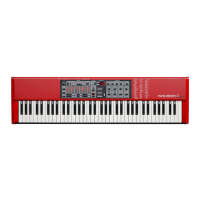and zones will be retained, when the box is checked, the samples and
zones will be restored.
Waveform graph
This is a visual representation of the audio file that is selected in the file
list. This graph will appear in other tabs as well, with minor alterations
in order to assist you in the editing process. If the audio file is in mono,
a single graph is drawn, if the audio file is in stereo, the left and right
channel will be presented in two parallel graphs. You can select a part
of, or an entire audio file by a standard click-and-drag procedure with
the mouse.
If the entire duration of the audio file will not fit in the waveform graph,
you can scroll the content of the graph by using the scroll bar below
the graph display.
Waveform Graph Colors
Colors are used to define areas and elements in the graph. The actual
waveform data is drawn in red. An undefined area is illustrated by a
gray background; a selected (but unassigned) area will have a dark
blue background.
If you right-click on a selected area, you can assign this selection as a
sample, with the Root Key setting from the Manual Sample Assign area.
When one or several parts of a audio file has been assigned as one or
several samples, this will be indicated in the waveform with alternat-
ing lighter and darker colors, in the same fashion as the zones are
indicated in the Keyboard Grid. If the sample is in focus, this will be
illustrated with a yellow color.
Zoom buttons and slider
Zoom in on the waveform using the zoom buttons and the zoom slider.
The buttons below the graph labeled All, 50, 20 etc are the zoom
buttons for the X-axis - the duration of the audio expressed in seconds.
If you select All, the entire duration will fit in the graph, if you e.g. select
2, 2 seconds of the audio will fit in the graph. Clicking on the 50m, 20m
or 10m buttons will show 50, 20, and 10 milliseconds sections of the
audio file.
The zoom factor for the Y-axis - the amplitude - is done
with the selectors and/or the slider at the lower, right
corner. The level of 1.0 represents the full amplitude - 0
dBFS- relative to the bit depth of the audio file.
Single Sample Per File Assign
This function allows you to easily map
samples to a Zone, where the Root
Key of the sample is based on a cer-
tain string of characters in the audio
file’s filename.
Name
This function use a naming convention where the pitch or note name is
indicated in the actual file name. A file that has the name celloC#4.wav
will be mapped with the Root Key on C sharp, in the middle octave -
when the Octave Shift on the Nord Wave is set to 0. The function can
interpret the Root Key, a sharp sign (#) and the octave.
Number
Uses a number in the file name and interprets this as a Root Key
number. The middle C, C4 on the Nord Electro 3 keyboard - when the
Octave Shift on the Nord Electro 3 is set to 0 - is key number 60.
Select one or several audio files in the Audio File list and click on Assign
to assign the samples to Zones. You can use the Ctrl key (or right-click)
to select nonconsecutive files in the list.
Multi Sample Per File Assign
This function can create sev-
eral samples and assign these to
zones from a single audio file with
recordings of several individual
notes, one after the other.
Start Note
Set this to the match the pitch of the first recorded note in the audio file.
Range: F0 - C8
Interval
Set this to match the intervals between the recorded notes in the audio file.
Range -48 - 48 semitones
Threshold
The threshold setting is used to distinguish or separate the individual
notes from one and another in the audio file.
Range: -80 - 0 dB
Remap button
Select this to map the audio file again.
Assign button
This activates the assignment of the selected audio file, using the set-
tings you have entered for the parameters for the Multi Sample Assign
function.
Manual Sample Assign
This function can
create and assign a
sample from a selec-
tion in the current
audio file. Click and
drag in the waveform
graph to select a part of, or the entire current audio file.
Root Key
This is the note where the sample will play back at its original pitch (or
speed if the sample is non-pitched or a performance loop). If you make
consecutive selections, the setting will increase in steps of one semi
tone for each time you have assigned a sample.
You can also use this setting to adjust the Root Key of a mapped
sample. Put the sample in focus and adjust the value to the next avail-
able key.
Range: F0 - C8

